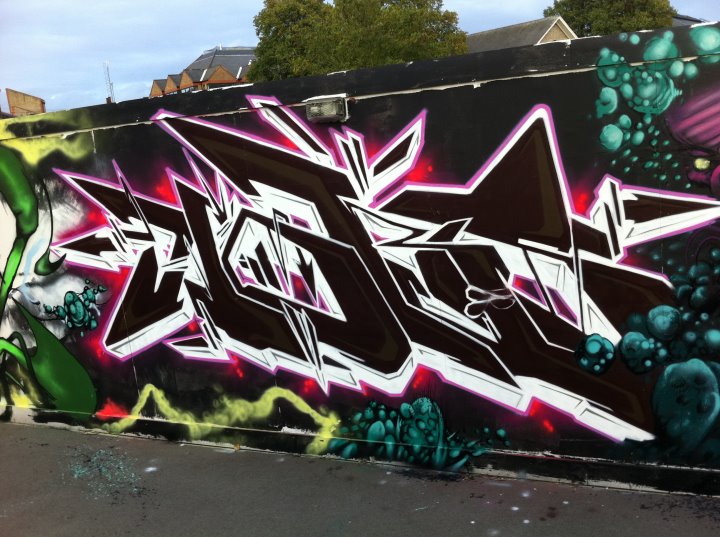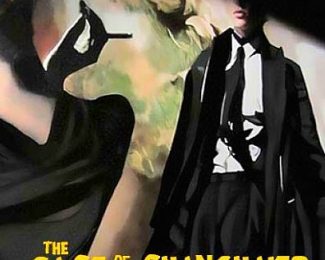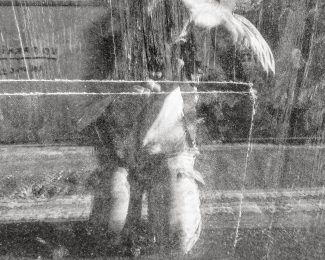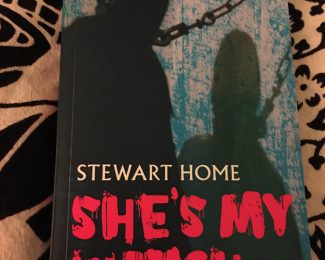
Glynn Judd
In October 2012, just months after contributing artwork for the Summer Olympic Games in London, graffiti writer Glynn ‘NOIR’ Judd was sentenced to spend 16 months behind bars alongside murderers and rapists. Under the Criminal Damage Act of 1971, Judd was enemy number one. Authorities wanted him, and he had eluded them – for a very long time.
With evidence citing a “graffiti kit” including bolt cutters, a London Underground high visibility jacket, spray cans, and a notebook containing locations of where stationary trains could be found, they had finally apprehended the then gainfully employed 40-year-old father of a young daughter. The story is compelling. It angered me when I read about it, because I just couldn’t reconcile a sentence that exceeded those imposed on violent criminals. Judd’s life as one of Britain’s most sought after graffiti vandals is documented in his fascinating book, “Addicted to Steel.” He is still actively writing, but now devotes his time to strictly legal pursuits such as galleries, workshops and educating youth about the perils and consequences of graffiti vandalism.
Graffiti artists, taggers, vandals, writers. Who are they and why do they do it?
NOIR, ZEPHYR, JULIO 204,VAMP, SAMO, TAKI183, PHASE 2, ZORO, BLADE, DAZE, LADY PINK, COPE2, SEEN, ROID, SICKBOY, REVS, SENTO, MITCH 77, NWC, GHOST.
– ALL CITY, BUFF, BOMB, DEF, DOPE, GETTING UP, LAYUP, MAD, BURNER, SCRUB, TAG, THROWUP… WRITER…
“WRITER” – A practitioner of the art of graffiti.
Having grown up in Los Angeles in the 70’s and 80’s, I have seen my fair share graffiti on trains and city walls, from ‘SABER’S illegal 97-gallon of paint LA River Project, which took a year to complete and was gone in a day, to all city tagger, ‘CHAKA,’ aka Daniel Ramos, whose name is visible on Dave Grohl’s drum kit in Nirvana’s Teen Spirit video, as well as on walls and alleyways throughout Los Angeles, to the elusive ‘OILER’ spotted over impossible heights on freeway overpass signs – theorising, “The more difficult to reach…the more difficult to buff.” The damage or décor mysteriously appeared, was painted over, only to reappear in the same places, over and over again, as if by phantoms.

SABER – LA River Project

Nirvana – “Smells Like Teen Spirit”

Daniel Ramos – aka ‘CHAKA’
Their stories are often the same – lower income, economically depressed, socially oppressed, mostly, but not always male, risking fines and imprisonment, or in the case of train writers, the knowledge that one slipped step onto the third rail carries the risk of electrocution, dismemberment, and possibly death – all for the thrill of the chance to create, in a very brief moment in time – their 15 minutes…
To be seen…
To be heard…
To matter.

aka ‘OILER’
Originating in Philadelphia in the mid 60’s, graffiti gained widespread popularity in New York City in the early 70’s – A response to the disparate gap that isolated the economic depression of project housing from urban opportunity. Using a combination of nicknames and street numbers, often working in crews, taggers ‘bombed’ subway trains with their work, creating in essence a travelling gallery; but is it art, or is it vandalism?


Taki183
Artist, tagger, writer or vandal? It’s an interesting debate that makes me wonder if the Paleolithic cave painters of Lascaux stirred up similar controversy.

Presumably, if it’s invited, it’s art; and there are many legal walls here in the US and abroad where writers can safely paint to their heart’s content without risking arrest. If, however, you’re trespassing it crosses the line into criminal damage vandalism. But just because it’s a crime doesn’t mean it’s not also art. To perfect his craft, Michelangelo was allowed to dissect cadavers from a monastery in Florence. Would his illegal procurement of the bodies taint the Sistine Chapel as not art?
When illegally scrawled on a New York City subway wall it’s vandalism…

Photo – Erik Calonius – NYC (1973)
Yet when transported to the walls of The Museum of Modern Art, it’s Post Modernism…

Jean-Michel Basquiat
Undoubtedly, those within the graffiti subculture in Europe and here in the US were already well acquainted with Glynn Judd, aka ‘NOIR’ – But whilst most graffiti vandals were existing in the shadows, Judd maintained the double life of respectable career man by day, art vandal by night, his career spanning more than a decade as one of the most notorious and prolific train writers in history.

Glynn Judd – ‘NOIR’
If you happened to be watching the 2012 London Summer Olympics, you will have noticed his artwork decorating the house danced in by UK rapper, Tinie Tempah, but for Judd, it was and always has been all about train writing.
I recently had the chance to interview fellow “Noir” artist, Judd, and what he told me you may or may not agree with, but of this I am certain, whether you agree with him or not, just as whether you believe graffiti is art or not, is of passing concern to those who live and are sometimes willing to die by their own rules. Justice, fines and sentencing may sometimes alter their choices, but it will never stop their passion for writing.
To be seen…
To be heard…
To matter.
A: I was originally using the name NOK ONE to write on trains. After a few years of travelling the world applying my name to as many surfaces as possible I realised the British Police were building a case against me and tracking me down. I had spent a lot of time in Europe so I decided to change my name and style of writing to throw off the scent of the cops who were chasing me. After spending time on the Paris metro system I came across a billboard advert that had “Think NOIR” written across it. I took the name and the rest is history as they say.
A: I tagged my first train when I was 13 years old. It wasn’t the best piece of work but it made me feel part of the movement I loved and followed religiously. I guess looking back at the first train I was oblivious to what I was doing or the risks involved. It just felt right for me to be doing it and not to think about the consequences that would follow a few decades later.
A: Absolutely. The film Beat Street was the first graffiti film I watched and I also had the album cover which had images of the ‘Ramon’ whole car on the back. I studied that record cover daily, biting the style and thinking about how to bend letters to look like that. Of course when the film Style Wars came to the UK that was it, the explosion happened and from 1984 graffiti in Britain exploded. Henry Chalfant’s book Subway Art was a bible to us kids growing up. It gave me the structure in how to transform letters to fit their surroundings, be it on a train or wall.

A: To me my endeavours were personal. I have and still do to this day, spray graffiti for myself. It has never been about exposure, fame or the money. Being a ‘writer’ is all about individuality and what your actions mean to yourself, not others.
A: Real soldiers walk alone. You look after yourself, keep yourself in check and only have yourself to blame if the plan goes wrong.

Glynn Judd – ‘NOIR’
A: London was buzzing with the Olympics arrival. The police and local authourities were cleaning up London fast with cleaner roads, homeless people being carted off never to be seen again, public transport, roads and train tracks cleaned from graffiti. London had never looked so clean. Film director, Danny Boyle, who put the opening ceremony together, felt that London’s graffiti heritage should be reflected in his grand opening. I was asked along with others to do some graffiti for a house that was to be featured in the show. It was ironic that London was cleaned of graffiti only for it to take center stage at the Olympic ceremony that was beamed around the world.

Glynn Judd – ‘NOIR’
A: Its a proven fact. If you look at individual cases involving graffiti and the sentences passed out to those accused of the act you will see a pattern emerge that a standard 2 year jail sentence for committing criminal damage on a train is given out frequently. If you on the other hand look at sentencing handed out to people accused of violence to a person or a child you will see an alarming number of sentences handed out like fines or suspended sentences or small custodial sentences. A person found guilty of raping a child will receive a lighter sentence than a person causing criminal damage to a train. So what is more valuable, property or people?
A: The book was a dramatisation of a few of the experiences that I had travelling around the world painting trains. It was a reflection of how I got myself into and out of trouble on a regular basis. It was to show the reader that not all vandals are council housed and violent or come from broken homes without jobs or any prospects for the future. The book was an insight to a world that exists hidden from society deep under the streets of many global cities. Whilst the general public were sleeping I was busy painting.
The future holds many things and I now travel the world talking about my experiences to audiences who will listen. Its more educational speaking as to warn others that painting trains does have consequences, be it incarceration or possibly death. I also concentrate on gallery work and creating murals for educational courses these days. It’s much safer and more financially viable for me. I regularly appear on national radio and TV concerning graffiti related issues and events.
For any further queries including commission work, art installations or promotional speaking please contact my agent Dusty at www.1717alliance.com
Glynn NOIR Judd
@ATS_BOOK








